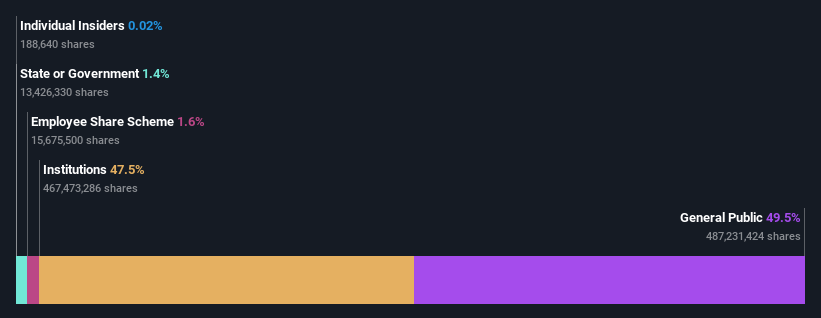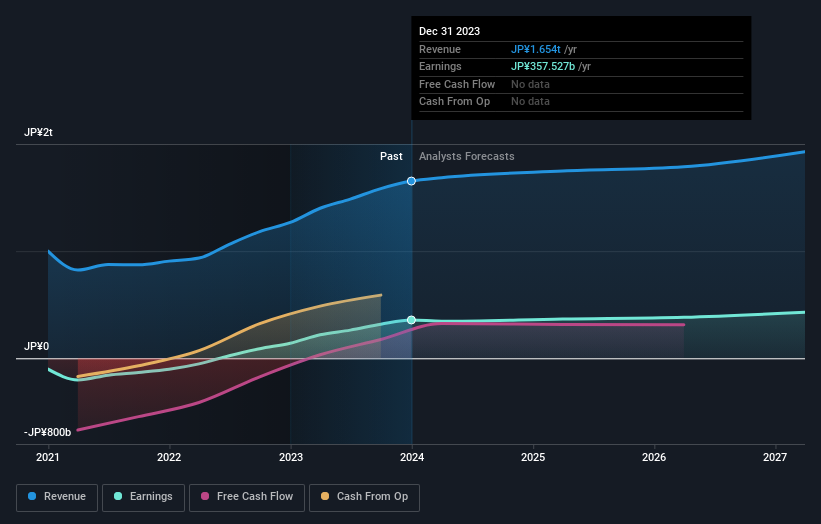Stock Analysis
- Japan
- /
- Transportation
- /
- TSE:9022
While institutions own 48% of Central Japan Railway Company (TSE:9022), individual investors are its largest shareholders with 50% ownership

Key Insights
- The considerable ownership by individual investors in Central Japan Railway indicates that they collectively have a greater say in management and business strategy
- The top 25 shareholders own 46% of the company
- Institutions own 48% of Central Japan Railway
A look at the shareholders of Central Japan Railway Company (TSE:9022) can tell us which group is most powerful. We can see that individual investors own the lion's share in the company with 50% ownership. Put another way, the group faces the maximum upside potential (or downside risk).
Meanwhile, institutions make up 48% of the company’s shareholders. Large companies usually have institutions as shareholders, and we usually see insiders owning shares in smaller companies.
In the chart below, we zoom in on the different ownership groups of Central Japan Railway.
View our latest analysis for Central Japan Railway

What Does The Institutional Ownership Tell Us About Central Japan Railway?
Many institutions measure their performance against an index that approximates the local market. So they usually pay more attention to companies that are included in major indices.
As you can see, institutional investors have a fair amount of stake in Central Japan Railway. This suggests some credibility amongst professional investors. But we can't rely on that fact alone since institutions make bad investments sometimes, just like everyone does. If multiple institutions change their view on a stock at the same time, you could see the share price drop fast. It's therefore worth looking at Central Japan Railway's earnings history below. Of course, the future is what really matters.

Central Japan Railway is not owned by hedge funds. BlackRock, Inc. is currently the largest shareholder, with 5.7% of shares outstanding. MUFG Bank, Ltd.,Investment Banking Arm is the second largest shareholder owning 5.4% of common stock, and MUFG Bank, Ltd., Retirement Benefit Trust holds about 3.6% of the company stock.
A deeper look at our ownership data shows that the top 25 shareholders collectively hold less than half of the register, suggesting a large group of small holders where no single shareholder has a majority.
Researching institutional ownership is a good way to gauge and filter a stock's expected performance. The same can be achieved by studying analyst sentiments. There are plenty of analysts covering the stock, so it might be worth seeing what they are forecasting, too.
Insider Ownership Of Central Japan Railway
The definition of company insiders can be subjective and does vary between jurisdictions. Our data reflects individual insiders, capturing board members at the very least. Company management run the business, but the CEO will answer to the board, even if he or she is a member of it.
I generally consider insider ownership to be a good thing. However, on some occasions it makes it more difficult for other shareholders to hold the board accountable for decisions.
Our most recent data indicates that insiders own less than 1% of Central Japan Railway Company. As it is a large company, we'd only expect insiders to own a small percentage of it. But it's worth noting that they own JP¥690m worth of shares. It is always good to see at least some insider ownership, but it might be worth checking if those insiders have been selling.
General Public Ownership
The general public-- including retail investors -- own 50% stake in the company, and hence can't easily be ignored. This size of ownership, while considerable, may not be enough to change company policy if the decision is not in sync with other large shareholders.
Next Steps:
I find it very interesting to look at who exactly owns a company. But to truly gain insight, we need to consider other information, too. Consider for instance, the ever-present spectre of investment risk. We've identified 1 warning sign with Central Japan Railway , and understanding them should be part of your investment process.
If you would prefer discover what analysts are predicting in terms of future growth, do not miss this free report on analyst forecasts.
NB: Figures in this article are calculated using data from the last twelve months, which refer to the 12-month period ending on the last date of the month the financial statement is dated. This may not be consistent with full year annual report figures.
Valuation is complex, but we're helping make it simple.
Find out whether Central Japan Railway is potentially over or undervalued by checking out our comprehensive analysis, which includes fair value estimates, risks and warnings, dividends, insider transactions and financial health.
View the Free AnalysisHave feedback on this article? Concerned about the content? Get in touch with us directly. Alternatively, email editorial-team (at) simplywallst.com.
This article by Simply Wall St is general in nature. We provide commentary based on historical data and analyst forecasts only using an unbiased methodology and our articles are not intended to be financial advice. It does not constitute a recommendation to buy or sell any stock, and does not take account of your objectives, or your financial situation. We aim to bring you long-term focused analysis driven by fundamental data. Note that our analysis may not factor in the latest price-sensitive company announcements or qualitative material. Simply Wall St has no position in any stocks mentioned.
About TSE:9022
Central Japan Railway
Central Japan Railway Company engages in the railway and related businesses in Japan.
Good value with proven track record.

